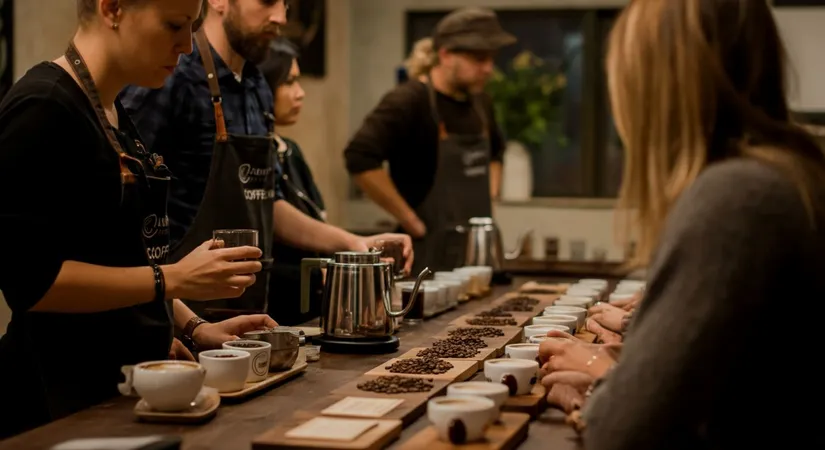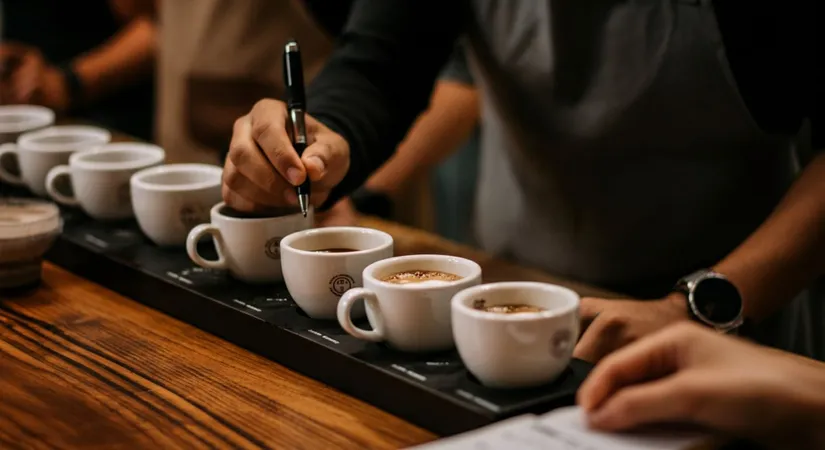Mastering Coffee Cupping: A Journey Through Techniques and Tasting
Unlock the secrets of coffee cupping. Master the techniques and elevate your coffee experience with our expert guide.
Coffee cupping is a treasured tradition among coffee enthusiasts, baristas, and connoisseurs worldwide. It offers a unique opportunity to explore the intricate flavors, aromas, and profiles of various coffee beans. Whether you are a seasoned coffee professional or a curious novice, mastering the art of coffee cupping can significantly enhance your coffee experience. In this blog, we delve into the essentials of coffee cupping, guide you through the process, and explore the sensory pleasures it brings. Join us on this flavorful journey.
Understanding the Basics: What is Coffee Cupping?
The Ritual of Coffee Cupping
Coffee cupping is a ritualistic process that involves evaluating coffee's sensory attributes. This practice is essential for maintaining consistency and determining coffee grades. It allows coffee enthusiasts to explore the diverse flavors and aromas that different beans offer.
Key Elements of Coffee Cupping
- Consistency: Ensures uniformity in coffee quality across batches.
- Flavor Exploration: Offers a platform to discover unique coffee profiles.
- Quality Control: Helps in identifying defects and maintaining standards.
How to Perform Coffee Cupping
- Preparation: Measure and grind coffee beans to a specific coarseness.
- Brewing: Pour hot water over the grounds and let them steep.
- Tasting: Break the crust, inhale the aroma, and taste the coffee.

Step-by-Step Guide: How to Perform Coffee Cupping
Unveiling Coffee's Aromatic Secrets
Embarking on a coffee cupping journey begins with the meticulous preparation of coffee grounds. The initial dry aroma offers a preview of the coffee's potential flavors. This stage is crucial for identifying the unique aromatic notes that each coffee variety possesses.
The Art of Tasting and Evaluation
Once the coffee has steeped, breaking the crust releases a burst of aromas. This moment is pivotal for evaluating the coffee's fragrance and flavor profile. Tasting involves a careful assessment of sweetness, acidity, and overall flavor harmony.
Essential Steps in Coffee Cupping
- Grind the coffee beans and note the dry aroma.
- Pour boiling water over the grounds and observe the bloom.
- Break the crust, inhale deeply, and taste the coffee.
Key Characteristics to Observe
- Sweetness: Indicates the presence of sugars and balance.
- Acidity: Provides brightness and liveliness to the flavor.
- Flavor Congruency: Ensures all elements harmonize seamlessly.

Exploring the Best Coffee Cupping Techniques
Enhancing the Cupping Experience
To elevate the coffee cupping experience, consider using filtered water and preheated cups. These elements help in achieving purer tasting notes, allowing the true flavors of the coffee to shine. Adjusting water temperature and grind size can also reveal different flavor profiles, offering a deeper understanding of the coffee's complexity.
Precision in Timing and Technique
Precision in timing during the steeping and tasting stages is crucial. This meticulous approach can significantly impact the final outcome, highlighting subtle nuances in flavor and aroma. By experimenting with these variables, coffee enthusiasts can uncover unique characteristics of each coffee variety.
Key Techniques for Optimal Flavor
- Filtered Water: Ensures clarity and purity in tasting notes.
- Preheated Cups: Maintains consistent temperature for accurate evaluation.
- Variable Grind Size: Unveils diverse flavor profiles and textures.
Steps to Mastering Coffee Cupping
- Prepare filtered water and preheat cups for optimal conditions.
- Experiment with different grind sizes to explore flavor variations.
- Time the steeping and tasting stages precisely for best results.
The Art of Coffee Aroma Evaluation and Sensory Analysis
Mastering Coffee Aroma Evaluation
In coffee cupping, aroma evaluation is pivotal for uncovering the coffee's essence. By isolating distinct aromas, one can identify both the coffee's inherent qualities and potential defects. This practice involves matching aromas with common descriptors, enhancing the sensory experience.
Refining Your Palate Through Sensory Analysis
Sensory analysis training is essential for refining one's palate. By focusing on identifying sweet, salty, and umami notes, coffee enthusiasts can develop a nuanced understanding of flavor profiles. This skill is crucial for accurate coffee tasting and flavor profiling.
Key Techniques for Aroma Evaluation
- Isolation of Aromas: Focus on individual scents to identify unique characteristics.
- Descriptor Matching: Use common coffee descriptors to articulate aroma profiles.
- Defect Detection: Recognize off-notes that may indicate quality issues.
Steps to Enhance Sensory Analysis Skills
- Practice identifying basic taste notes like sweet, salty, and umami.
- Engage in regular aroma training sessions to improve scent recognition.
- Participate in diverse coffee tastings to broaden flavor understanding.
Mastering the Art of Coffee Cupping: Techniques and Sensory Analysis
Precision in Coffee Cupping: Techniques for Optimal Flavor
Frequently Asked Questions
What is coffee cupping and why is it important?
How do you perform coffee cupping?
What are the best techniques for coffee cupping?
How does coffee aroma evaluation enhance the cupping process?
What are the key characteristics to observe during coffee cupping?
Discover the path to a healthier, more beautiful you with estethica's award-winning services. Call now for your free consultation and take the first step towards transformation!
📞 Call Us Today for a Free Consultation